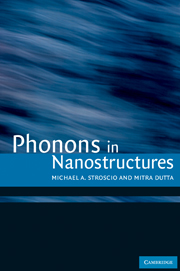Book contents
- Frontmatter
- Contents
- Preface
- Chapter 1 Phonons in nanostructures
- Chapter 2 Phonons in bulk cubic crystals
- Chapter 3 Phonons in bulk würtzite crystal
- Chapter 4 Raman properties of bulk phonons
- Chapter 5 Occupation number representation
- Chapter 6 Anharmonic coupling of phonons
- Chapter 7 Continuum models for phonons
- Chapter 8 Carrier–LO-phonon scattering
- Chapter 9 Carrier–acoustic-phonon scattering
- Chapter 10 Recent developments
- Chapter 11 Concluding considerations
- Appendices
- References
- Index
Chapter 2 - Phonons in bulk cubic crystals
Published online by Cambridge University Press: 09 October 2009
- Frontmatter
- Contents
- Preface
- Chapter 1 Phonons in nanostructures
- Chapter 2 Phonons in bulk cubic crystals
- Chapter 3 Phonons in bulk würtzite crystal
- Chapter 4 Raman properties of bulk phonons
- Chapter 5 Occupation number representation
- Chapter 6 Anharmonic coupling of phonons
- Chapter 7 Continuum models for phonons
- Chapter 8 Carrier–LO-phonon scattering
- Chapter 9 Carrier–acoustic-phonon scattering
- Chapter 10 Recent developments
- Chapter 11 Concluding considerations
- Appendices
- References
- Index
Summary
The Creator, if He exists, has a special preference for beetles.
J.B.S. Haldane, 1951Cubic structure
Crystals with cubic structure are of major importance in the fields of electronics and optoelectronics. Indeed, zincblende crystals such as silicon, germanium, and gallium arsenide may be regarded as two face-centered cubic (fcc) lattices displaced relative to each other by a vector (a/4, a/4, a/4), where a is the size of the smallest unit of the fcc structure. Figure 2.1 shows a lattice with the zincblende structure.
A major portion of this book will deal with phonons in cubic crystals. In addition, we will describe the phonons in so-called isotropic media, which are related mathematically to cubic media as explained in detail in Section 7.2. The remaining portions of this book will deal with crystals of würtzite structure, defined in Chapter 3. More specifically, the primary focus of this book concerns phonons in crystalline structures that are dimensionally confined in one, two, or three dimensions. Such one-, two-, and three-dimensional confinement is realized in quantum wells, quantum wires, and quantum dots, respectively. As a preliminary to considering phonons in dimensionally confined structures, the foundational case of phonons in bulk structures will be treated. The reader desiring to supplement this chapter with additional information on the basic properties of phonons in bulk cubic materials will find excellent extended treatments in a number of texts including Blakemore (1985), Ferry (1991), Hess (1999), Kittel (1976), Omar (1975), and Singh (1993).
Ionic bonding – polar semiconductors
As is well known, the crystal structure of silicon is the zincblende structure shown in Figure 2.1.
- Type
- Chapter
- Information
- Phonons in Nanostructures , pp. 6 - 15Publisher: Cambridge University PressPrint publication year: 2001



